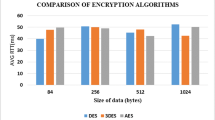Abstract
Content protection that allows only legitimate users to use specified content is essential in order to secure business in the consumer market. However, service providers and users suffer from low responsiveness when content is encrypted with traditional cryptographic tools that require strong decryption algorithms on mobile devices. In this paper, we introduce a generic partial encryption scheme for low-power mobile devices. Our primary goal is to design a generic architecture for partial encryption of downloadable and real-time streaming contents, and also to facilitate a trade-off between minimizing the encryption/decryption overhead and providing sufficient DRM security for the service provider. We also evaluate the efficacy of our proposed scheme by applying it to real-world multimedia contents. The results of our experiments indicate that encrypting only a small portion (about 2.5 %) of video content can effectively impose DRM restriction on the content. This significantly reduces the decryption overhead on low-power mobile devices. In the smart phone environment, it is shown that the time overhead during the decryption is less that 5 % of on-the-fly decoding time and the power overhead is reduced by up to 94.5 %, compared to the traditional full encryption scheme.












Similar content being viewed by others
References
Abomhara M, Zakaria O, Khalifa O, Zaidan A, Zaidan B (2010) Enhancing selective encryption for H.264/AVC using advanced encryption standard. Int J Comput Theory Eng 2(2):223–229
Bellare M, Desai A, JokiPii E, Rogaway P (1997) A concrete security treatment of symmetric encryption: Analysis of the DES modes of operation. Proceedings of the 38th Symposium on Foundations of Computer Science, IEEE
Furht B, Socek D, Eskicioglu AM (2004) Fundamentals of multimedia encryption techniques. In: Furht B, Kirovski D (eds) Multimedia security handbook. CRC Press, LLC, ch. 3, pp 93–131
Han J-K, Chang H-Y, Cho S, Park M (2008) EMCEM: An Efficient Multimedia Content Encryption scheme for Mobile handheld devices. In: Proceedings of the 2008 International Conference on Information Science and Security, pp 108–114
Huynh-Thu Q, Ghanbari M (2008) Scope of validity of PSNR in image/video quality assessment. Electron Lett 44(13):800–801
Le Gall D (1991) MPEG: A video compression standard for multimedia applications. Communications of the ACM, retrieved 2008-04-09
Li C, Zhou X, Zhong Y (2008) NAL level encryption for scalable video coding. Lect Notes Comput Sci Springer 5353:496–505
Lian S, Liu Z, Ren Z, Wang H (2007) Commutative encryption and watermarking in video compression. IEEE Trans Circ Syst Video Technol 17(6):774–778
Liu X, Eskicioglu AM (2003) Selective encryption of multimedia content in distribution networks: Challenges and new directions. In: 2nd Int. Conf. Communications, Internet, and Information Technology, Scottsdale, AZ, Nov. 17–19, 2003
Mauro B, ed (2006) Fractal image compression. Document and image compression (CRC Press) 968:168–169
McGrew D (2002) Counter mode security: Analysis and recommendations. http://citeseer.ist.psu.edu/mcgrew02counter.html, 2002
Open Mobile Alliance (2004) DRM specification V2.0. Open Mobile Alliance Ltd, La Jolla (CA), USA
Open Mobile Alliance Ltd, http://www.openmobilealliance.com
Shahid Z, Chaumont M, Puech W (2011) Fast protection of H.264/AVC By Selective Encryption Of CAVLC And CABAC For I & P frames. IEEE Trans Circ Syst Video Technol 21(5):565–576
Thomos N, Boulgouris NV, Strintzis MG (2006) Optimized transmission of JPEG2000 streams over wireless channels. IEEE Trans Image Process 15(1)
Welstead ST (1999) Fractal and wavelet image compression techniques. SPIE, Publication, pp 155–156
Wu C-P, Kuo C-C (2005) Design of integrated multimedia compression and encryption systems. IEEE Trans Multimed 7:828–839
Xiangjun L, Jianfei C (2007) Robust transmission of JPEG2000 encoded images over packet loss channels. ICME 2007 School of Computer Engineering, Nanyang Technological University, pp 947–950
Acknowledgments
This research was supported by Next-Generation Information Computing Development Program through the National Research Foundation of Korea (NRF) funded by the Ministry of Education, Science and Technology (2012-0006419).
Author information
Authors and Affiliations
Corresponding author
Rights and permissions
About this article
Cite this article
Jeong, E.S., Kim, B.H. & Lee, D.H. A generic partial encryption scheme for low-power mobile devices. Multimed Tools Appl 72, 2087–2106 (2014). https://doi.org/10.1007/s11042-013-1389-9
Published:
Issue Date:
DOI: https://doi.org/10.1007/s11042-013-1389-9




